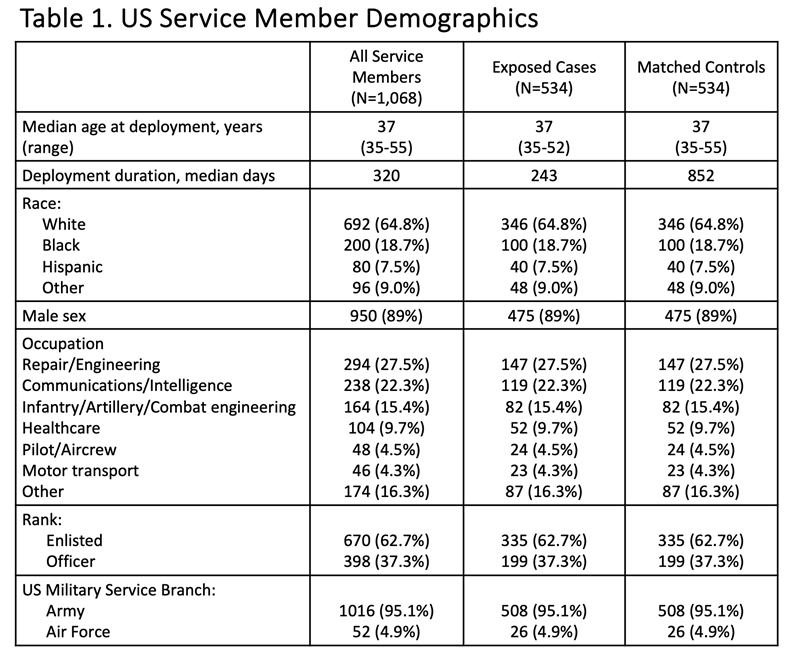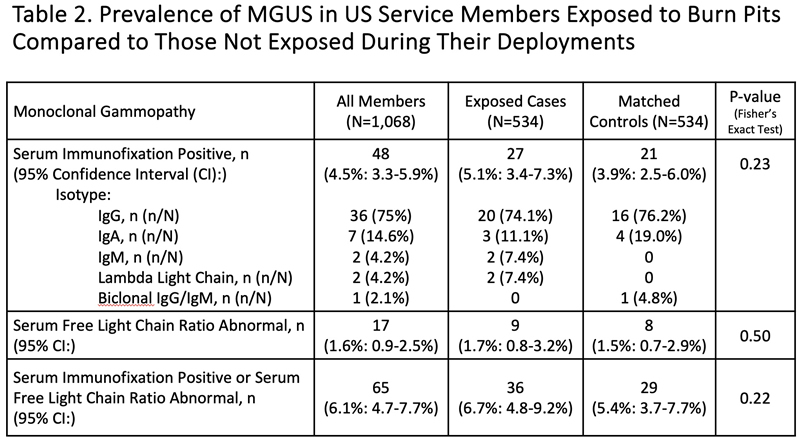BETHESDA, MD—A presentation at the 65th American Society of Hematology Annual Meeting in 2023, identified a conundrum of significant interest to servicemembers, veterans and the clinicians who treat them. Individuals who have served in the U.S. military have about three times the risk of monoclonal gammopathy of undetermined significance (MGUS) as a similarly aged cohort in the Icelandic iStopMM study and the most likely explanation—exposure to burn pits in Southwest Asia—does not appear to be a factor.
That is surprising, as many studies have demonstrated an association between MGUS and pesticides and toxins released by fires. Further, the VA PACT Act added a number of malignancies, including all lymphatic cancers and lymphomas, as presumptive conditions for veterans exposed to burn pit and other airborne hazards during service in Iraq and Afghanistan. MGUS, a plasma cell dyscrasia, always precedes multiple myeloma, a common hematologic cancer.
Given this background, investigators at the Walter Reed National Military Medical Center and the National Cancer Institute, both in Bethesda, MD, and the Sylvester Comprehensive Cancer Center in Miami, aimed to determine whether servicemembers deployed to Iraq had an increased risk of MGUS.
To do so, they obtained serum samples and clinical data for 1,068 individuals from the Armed Forces Health Surveillance Division, the U.S. military’s central epidemiologic health registry and biorepository. The cohort included 534 individuals deployed to Iraq between Jan. 1, 2005, and June 30, 2007, who reported exposure to burn pits and other airborne hazard. These servicemembers were matched 1:1 to servicemembers deployed to Germany who were never sent to Southwest Asia and did not report toxic exposures.
All cases had deployments of at least six months and were a minimum of 35 years old at the time of deployment. They all also remained in the service for at least another 10 years and had serum stored at the AFHSD repository 10 years after deployment. The two groups were matched for deployment year, age, sex, service branch, military rank and occupation.

Kazandjian D, DeStafano C, Dew A, Hill E, Thoren K, Landgren O. Increased Risk of Monoclonal Gammopathy of Undetermined Significance in U.S. Military Service Members: A Case-Controlled Study of 1,068 Service Members Deployed to Either Europe or Iraq, with or without Reported Burn Pit and Toxic Smoke Exposure. Abstract 4770. ASH 2023. December 11, 2023.

Kazandjian D, DeStafano C, Dew A, Hill E, Thoren K, Landgren O. Increased Risk of Monoclonal Gammopathy of Undetermined Significance in U.S. Military Service Members: A Case-Controlled Study of 1,068 Service Members Deployed to Either Europe or Iraq, with or without Reported Burn Pit and Toxic Smoke Exposure. Abstract 4770. ASH 2023. December 11, 2023.
The team tested the post-deployment samples for monoclonal protein indicative of MGUS. They found no statistically significant difference in MGUS prevalence between the two groups, with 6.7% of the burn pit exposed group having MGUS (95% Confidence Interval (CI): 4.8-9.2%) compared to 5.4% of the control group (95% CI: 3.7-7.7%, p=0.22).
While no difference was seen in risk of MGUS based on deployment, the study found that 6.1% of the total study population had MGUS (95% CI: 4.7-7.7%). “When taking into account that the median age at deployment was 37 years and samples were attained 10 years later (approximately at an age of 47 years), the observed prevalence is threefold higher than that reported in the Icelandic iStopMM study (2% in the 41-50-year age group),” the researchers noted.
IStopMM is the first large-scale screening study in myeloma. Funded by the International Myeloma Foundation, the study aims to screen the entire population of Iceland over the age of 40 for the presence of MGUS and multiple myeloma.
While many factors could contribute to the difference in prevalence seen in the Icelandic population and the U.S. military, the research team urged further exploration to elucidate causes for the increased prevalence of MGUS among U.S. military servicemembers.
- Kazandjian D, DeStafano C, Dew A, Hill E, Thoren K, Landgren O. Increased Risk of Monoclonal Gammopathy of Undetermined Significance in U.S. Military Service Members: A Case-Controlled Study of 1,068 Service Members Deployed to Either Europe or Iraq, with or without Reported Burn Pit and Toxic Smoke Exposure. Abstract 4770. ASH 2023. December 11, 2023.


